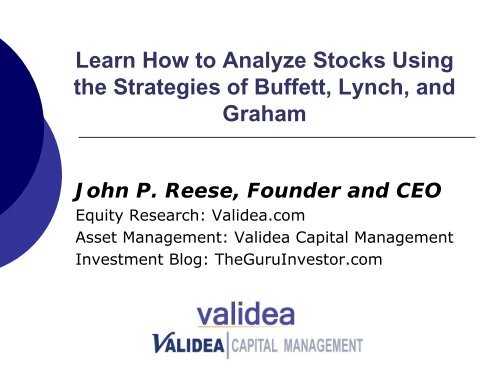Learn How to Analyze Stocks Using the Strategies of Buffett, Lynch ...
Learn How to Analyze Stocks Using the Strategies of Buffett, Lynch ...
Learn How to Analyze Stocks Using the Strategies of Buffett, Lynch ...
You also want an ePaper? Increase the reach of your titles
YUMPU automatically turns print PDFs into web optimized ePapers that Google loves.
<strong>Learn</strong> <strong>How</strong> <strong>to</strong> <strong>Analyze</strong> S<strong>to</strong>cks <strong>Using</strong><br />
<strong>the</strong> <strong>Strategies</strong> <strong>of</strong> <strong>Buffett</strong>, <strong>Lynch</strong>, and<br />
Graham<br />
John P. Reese, Founder and CEO<br />
Equity Research: Validea.com<br />
Asset Management: Validea Capital Management<br />
Investment Blog: TheGuruInves<strong>to</strong>r.com
Goal <strong>of</strong> <strong>to</strong>day’s presentation<br />
◦ Outline three quantitative investment<br />
strategies by highly successful gurus –<br />
<strong>Lynch</strong>, <strong>Buffett</strong> and Graham methods.<br />
◦ Discuss an investment framework that can<br />
help you become a better inves<strong>to</strong>r.<br />
◦ Look at a few investment ideas in real-time<br />
using Validea.com and analyze s<strong>to</strong>cks that<br />
you’re interested in.
Who: At Validea we follow numerous<br />
guru strategies, including:<br />
1. Peter <strong>Lynch</strong><br />
2. Ben Graham<br />
3. Warren <strong>Buffett</strong><br />
4. Ken Fisher<br />
5. David Dreman<br />
6. Martin Zweig<br />
7. James O'Shaughnessy<br />
8. John Neff<br />
9. William O'Neil<br />
10. Joseph Piotroski<br />
11. Joel Greenblatt
Why <strong>the</strong>se “Gurus”? Three key<br />
fac<strong>to</strong>rs.<br />
◦ 1) developed a framework <strong>to</strong> select<br />
s<strong>to</strong>cks that has delivered market<br />
outperformance<br />
◦ 2) publicly disclosed <strong>the</strong>se techniques<br />
ei<strong>the</strong>r in books, academic papers or<br />
o<strong>the</strong>r sources<br />
◦ 3) created a quantitative<br />
methodology that can be leveraged<br />
using a computer program
Let’s look at <strong>the</strong> quantitative<br />
strategies <strong>of</strong>:<br />
Peter <strong>Lynch</strong>
Peter <strong>Lynch</strong> – The Star “GARP”<br />
Manager<br />
1. EPS growth < 10% Slow-grower<br />
2. EPS growth ≥ 10% and < 20% Stalwart<br />
3. EPS growth ≥ 20% Fast-grower<br />
1. > 0 and ≤ 0.5 Pass—Best case<br />
2. > 0.5 and ≤ 1 Pass<br />
3. > 1 Fail
Methodology Example, Peter <strong>Lynch</strong><br />
1. If a financial or service company Not<br />
applicable<br />
2. Change in inven<strong>to</strong>ry/sales is negative<br />
Pass—Best case<br />
3. Change in inven<strong>to</strong>ry/sales = 0 Pass<br />
4. Change in inven<strong>to</strong>ry/sales is positive but<br />
≤ 5% Pass—Minimum<br />
5. Change in inven<strong>to</strong>ry/sales is positive<br />
and > 5 percentage points Fail
Methodology Example, Peter <strong>Lynch</strong><br />
1. If a financial or service company<br />
N/A (See tests below for financial firms)<br />
2. D/E < 30% Pass—Best case<br />
3. D/E ≥ 30% and < 50% Pass—Normal<br />
4. D/E ≥ 50% and < 80% Pass—Mediocre<br />
5. D/E ≥ 80%, and firm is a utility Pass<br />
6. D/E ≥ 80%, and firm is not a utility firm Fail<br />
Note: if financial firm use Equity-<strong>to</strong>-Assets & ROA
Methodology Example, Peter <strong>Lynch</strong><br />
1. Sales > $1 billion and PE ≤ 40 Pass<br />
2. Sales > $1 billion and PE > 40 Fail<br />
3. Sales ≤ $1 billion N/A<br />
1. ≥ 20% and ≤ 25% Pass—Best case<br />
2. > 25% and ≤ 50% Pass<br />
3. > 50% Fail
Methodology Example, Peter <strong>Lynch</strong><br />
1. Free Cash Flow Per Share <strong>to</strong> Current Price<br />
2. Net Cash per Share-<strong>to</strong>-Current Price<br />
Real Time Ideas & Analysis:<br />
<strong>Lynch</strong> Portfolio & Picks
Let’s look at <strong>the</strong> quantitative<br />
strategies <strong>of</strong>:<br />
Warren <strong>Buffett</strong>
Warren <strong>Buffett</strong> – The “Greatest”<br />
Guru<br />
1. Nature <strong>of</strong> firm’s business?<br />
2. Ability <strong>to</strong> pass on costs?<br />
3. Complexity <strong>of</strong> product / business model?<br />
Note: this is qualitative analysis vs. quantitative.
Methodology Example, Warren<br />
<strong>Buffett</strong><br />
1. Y1 ≥ Y2 ≥ Y3 ≥ Y4 ≥ Y5 ≥ Y6 ≥ Y7 ≥ Y8 ≥<br />
Y9 ≥ Y10 (No years with a negative EPS.)<br />
Pass-Best Case<br />
2. Y1 ≥ Y2 ≥ Y3 ≥ Y4 ≥ Y5 ≥ Y6 ≥ Y7 ≥ Y8 ≥<br />
Y9 ≥ Y10 (except for dips from a prior year’s<br />
earnings, that <strong>to</strong>tal no more than 45<br />
percent). No years with a negative EPS. Pass<br />
3. All o<strong>the</strong>r combinations Fail
Methodology Example, Warren<br />
<strong>Buffett</strong><br />
1. ≤ 2 times earnings Pass – Best case<br />
2. > 2 and ≤ 5 times earnings Pass<br />
3. > 5 times earnings Fail<br />
1. ≥ 15% Pass<br />
2. < 15% Fail<br />
1. ≥ 12% Pass<br />
2. < 12% Fail
Methodology Example, Warren<br />
<strong>Buffett</strong><br />
1. > 0 Pass<br />
2. ≤ 0 Fail<br />
1. ≥ 15% Pass—Best case<br />
2. ≥ 12% and < 15% Pass<br />
3. < 12% Fail
Methodology Example, Warren<br />
<strong>Buffett</strong><br />
IS THE PRICE RIGHT?<br />
1. Calculate expected return w/ROE method.<br />
2. Calculate expected return w/EPS method.<br />
3. Take <strong>the</strong> average <strong>of</strong> <strong>the</strong> ROE and EPS<br />
methods <strong>to</strong> determine if return is in <strong>the</strong><br />
acceptable range (likes <strong>to</strong> see 15%).<br />
Real Time Ideas & Analysis:<br />
<strong>Buffett</strong> Portfolio & Picks
Let’s look at <strong>the</strong> quantitative<br />
strategies <strong>of</strong>:<br />
Benjamin Graham
Ben Graham – The “Granddaddy” <strong>of</strong><br />
<strong>the</strong> Gurus<br />
1. All s<strong>to</strong>cks (including public utilities) besides<br />
technology firms Pass<br />
2. Technology s<strong>to</strong>cks Fail<br />
1. ≥ $340 million Pass<br />
2. < $340 million Fail<br />
1. Current ratio ≥ 2 Pass<br />
2. Current ratio < 2, and company is a utility<br />
or telecom Pass<br />
3. Current ratio < 2, and company is not utility<br />
or telecom Fail
Methodology Example, Ben Graham<br />
1. Long-term debt ≤ Net current assets Pass<br />
2. Long-term debt > Net current assets Fail<br />
1. ≥ 30%, and no negative annual EPS in last<br />
five years Pass<br />
2. < 30% Fail<br />
3. ≥ 30%, with negative annual EPS in any <strong>of</strong><br />
last five years Fail
Methodology Example, Ben Graham<br />
1. P/E ≤ 15 Pass<br />
2. P/E > 15 Fail<br />
1. P/B × P/E ≤ 22 Pass<br />
2. P/B × P/E > 22 Fail
Methodology Example, Ben Graham<br />
1. Industrial companies—D/E ≤ 100% Pass<br />
2. Utilities, phone companies, railroads—LTD/E<br />
≤ 230% Pass<br />
3. Industrial companies—D/E > 100% Fail<br />
4. Utilities, phone companies, railroads—LTD/E<br />
> 230% Fail<br />
Real Time Ideas & Analysis:<br />
Graham Portfolio & Picks
A look inside Validea and<br />
Validea Capital’s Key<br />
Investment Pillars
O<strong>the</strong>r Key Pillars In Strategy<br />
Rebalance<br />
Long Term<br />
All Cap<br />
• Monthly Rebalancing (opportunity cost <strong>of</strong><br />
not selling & best performance)<br />
• You need <strong>to</strong> stick <strong>to</strong> strategy for <strong>the</strong> long<br />
term<br />
• Look for opportunities across all market<br />
segments<br />
• Remove emotion from <strong>the</strong> equation<br />
• Hold baskets <strong>of</strong> 10, 20 or 50 s<strong>to</strong>cks<br />
• Equally weighted portfolio – i.e. with a 20<br />
s<strong>to</strong>ck model each holding accounts for 5%<br />
<strong>of</strong> portfolio<br />
Emotion<br />
Portfolio<br />
Construction
Redefining Long Term Investing<br />
◦ Don’t have <strong>to</strong> hold on<strong>to</strong> s<strong>to</strong>cks for <strong>the</strong><br />
long term <strong>to</strong> be a long term inves<strong>to</strong>r –<br />
goes against conventional wisdom<br />
◦ Hold on<strong>to</strong> <strong>the</strong> strategies for <strong>the</strong> long<br />
term not <strong>the</strong> s<strong>to</strong>cks<br />
Rebalance<br />
Long Term<br />
All Cap<br />
Emotion<br />
Portfolio<br />
Construction<br />
◦ Buy and Hold strategies, in our testing,<br />
fail <strong>to</strong> produce <strong>the</strong> best returns
To Be Successful You Need To Stick To<br />
The Strategy, Even After Down Years<br />
◦ Seminal Study by Joel Greenblatt in “The<br />
Little Book That Beats <strong>the</strong> Market”.<br />
Greenblattt is <strong>the</strong> founder <strong>of</strong> Gotham Capital<br />
Rebalance<br />
Long Term<br />
All Cap<br />
Emotion<br />
Portfolio<br />
Construction<br />
1 Year<br />
Period<br />
Underperformed<br />
25% <strong>of</strong><br />
<strong>the</strong> time<br />
2 Year<br />
Period<br />
Underperformed<br />
17% <strong>of</strong><br />
<strong>the</strong> time<br />
3 Year<br />
Period<br />
Outperfor<br />
med 95%<br />
<strong>of</strong> <strong>the</strong> time<br />
Source: Joel Greenblatt, “The Little Book That Beats <strong>the</strong> Market” (John Wiley<br />
& Sons, Inc., 2006)
Behavioral Finance: Inves<strong>to</strong>r Biases<br />
◦ Over Optimism: We are overoptimistic with our<br />
estimate <strong>of</strong> how we can do and <strong>to</strong> find good s<strong>to</strong>cks.<br />
◦ Overconfidence: Overconfident that your judgment<br />
is always right and creates and illusion <strong>of</strong> control and<br />
knowledge.<br />
◦ Recency : Peoples tendency <strong>to</strong> give <strong>to</strong>o much<br />
credence <strong>to</strong> <strong>the</strong>ir most recent, short term experience.<br />
Rebalance<br />
Long Term<br />
All Cap<br />
Emotion<br />
Portfolio<br />
Construction<br />
◦ Loss Aversion: Fear <strong>of</strong> losing money and<br />
subsequent inability <strong>to</strong> withstand short term events<br />
and maintain a long term perspective.
Portfolio Construction – equally<br />
weighted holdings and diversification<br />
• 10, 20 or 50 S<strong>to</strong>cks depending on multiple<br />
fac<strong>to</strong>rs like portfolio investment size and<br />
risk <strong>to</strong>lerance<br />
• You can’t beat <strong>the</strong> market by owning it<br />
Rebalance<br />
Long Term<br />
All Cap<br />
Emotion<br />
Portfolio<br />
Construction<br />
• Equally weighted shows optimal his<strong>to</strong>rical<br />
performance in <strong>the</strong> Validea system. Studies<br />
have shown equal weighting can generate<br />
outperformance over market cap weighted<br />
approaches.
<strong>Buffett</strong> Quote on Emotions &<br />
Discipline<br />
“Investing is not a game where <strong>the</strong> guy with <strong>the</strong> 160<br />
IQ beats <strong>the</strong> guy with <strong>the</strong> 130 IQ…Once you have<br />
ordinary intelligence, what you need is <strong>the</strong><br />
temperament <strong>to</strong> control <strong>the</strong> urges that get o<strong>the</strong>r<br />
people in<strong>to</strong> trouble in investing.”<br />
Rebalance<br />
Long Term<br />
All Cap<br />
Emotion<br />
Portfolio<br />
Construction<br />
"To invest successfully does not require a stra<strong>to</strong>spheric<br />
IQ, unusual business insights, or inside information.<br />
What's needed is a sound intellectual framework for<br />
making decisions and <strong>the</strong> ability <strong>to</strong> keep emotions<br />
from corroding <strong>the</strong> framework.“<br />
Warren <strong>Buffett</strong>, Chairman Berkshire Hathaway
Key Lessons We have <strong>Learn</strong>ed that<br />
will help maximize Long Term<br />
Performance<br />
• Understand <strong>the</strong> variables in <strong>the</strong> strategy. These<br />
have proven <strong>to</strong> be successful and predictive;<br />
• Stick <strong>to</strong> <strong>the</strong> strategy through <strong>the</strong> ups and downs<br />
and over <strong>the</strong> long term;<br />
• Examine and scan entire equity universe. Avoid<br />
looking at a few s<strong>to</strong>cks at a time;<br />
• Rebalance periodically (monthly, quarterly or<br />
annually) <strong>to</strong> ensure you are always holding <strong>the</strong><br />
highest scoring s<strong>to</strong>cks;<br />
• Adhere <strong>to</strong> <strong>the</strong> strategy with <strong>the</strong> utmost<br />
discipline and remove emotion.
Contact Us<br />
John Reese, Founder and CEO<br />
Equity Research: www.validea.com<br />
Asset Management: www.valideacapital.com<br />
johnreese@validea.com<br />
(800) 730.3457



